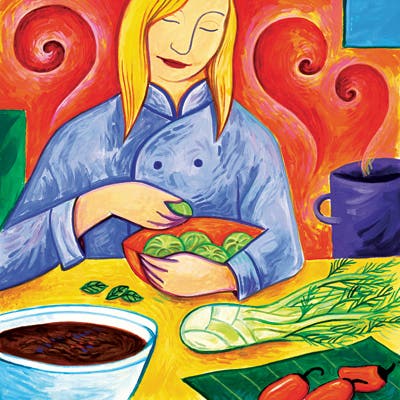
Command Performance for the President
I received the call from the White House while 11,000 feet above sea level on a visit to the Incan Temple of the Sun, in Cuzco, Peru. Would I cook for Fiesta Latina, a reception being thrown by the Obamas for 400 guests in honor of Hispanic Heritage Month? Maybe it was oxygen deprivation, but I grew dizzy. I'd never been asked to do anything this high profile. Anxious, I accepted as graciously as I could. You don't say no to the President.
When I returned to the States, I did what I always do when I'm nervous: I researched. I read accounts of Abigail Adams's reception at the newly completed White House in 1801, when floating island, a dessert of meringues and custard, was served. I read about Eisenhower's rooftop barbecues and canapes served on the White House lawn when Jackie Kennedy was in residence. And now there were the Obamas, arguably the most food-savvy First Family yet: avid restaurant-goers, supporters of sustainable agriculture, and originators of the White House Food Policy councils.
My head reeled. What was I going to cook? How would history judge me? Eventually, I calmed down and started to conceive a menu that would tell the story of Latin American cuisine through its staples: corn, beans, peppers, pork, chocolate. I included Puerto Rican pasteles (tamales made with starchy vegetables) and a fresh-corn Cuban polenta called tamal en cazuela, as well as the island's feast dish: lechon asado, or roast pork in a cumin-allspice adobo, plus several sweets, including a chocolate-cheese flan and a cortadito (espresso) creme brulee.
I arrived at the White House two days before Fiesta Latina. There, I met Cristeta Comerford, the White House chef, whose staff would help with my preparations. Cris showed me around the kitchen, a surprisingly small space whose equipment includes 12 burners, a gas grill, a salamander broiler, and a convection oven that doubles as a steamer.
Then we got down to work. Though the purchasing department had already delivered most of the ingredients I'd asked for, I picked some produce straight from the Obamas' garden. The 1,100-square-foot organic plot on the South Lawn that contains cilantro, green oak leaf lettuce, and black kale, plus chiles, parsley, and sweet orange tomatoes, some of which I cooked with tomatillos and fennel for a Brazilian arrumadinho, a composed dish of black-eyed peas, vegetable salad, and farofa (seasoned and toasted cassava flour).
As we cooked together, despite the pressure and time constraints, the White House staff and I learned from one another. When we discovered that we had received fresh pork belly instead of the slab bacon I'd requested to accompany the tamal en cazuela, Cris showed me how to cure the pork on the spot, brining it before smoking it with applewood chips in the convection oven. In turn, I taught the staff how to work with many ingredients that were new to them: cacao beans, hibiscus, malanga, as well as Peruvian purple corn, which the White House pastry chef, Bill Yosses, boiled with pineapple and dried fruits before mixing it all with sweet potato flour to create a rich pudding.
On Fiesta night, in the majestic Blue Room, which was decorated with the fresh chiles on the stem I had requested in lieu of flowers, I watched from the sidelines as the guests ate with gusto. The President, who revealed that he had been receiving samples of my dishes and tasting them all along as we cooked, was careful to say how much he enjoyed the food; and Supreme Court Justice Sonia Sotomayor even remarked that my pasteles were as good as her mother's. If praise from such high authorities is any indication, I trust that—thanks to the help of the White House staff—future historians will judge me kindly.
Keep Reading
Continue to Next Story










